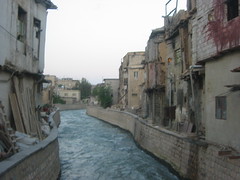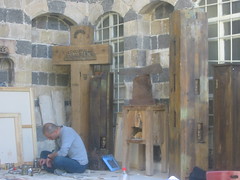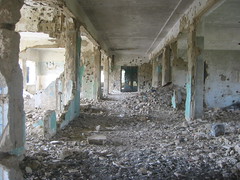Animal Life in my Kitchen
This morning I got up and stumbled to the kitchen to put water for tea on. I opened the door and was greeted by a sparrow flapping madly about and whizzing around the kitchen. I shut the door. When I opened it again the bird flew rapidly towards my head then spun around and made a dash for the glass doors leading to the balcony, crashed, then hopped around and settled on top of the refrigerator. I glanced up at it. It blinked at me sadly.
Arming myself with a pot lid to protect myself in case the sparrow decided to dive towards my head again, I ran to the doors, opened them, then closed the kitchen door and waited a few minutes to head back into the kitchen.
I cautiously opened the door. No sparrow flapping about. No bird on top of the refrigerator. Excellent. I shut the balcony door, made my tea, grabbed a banana, then started to walk out to the living room to enjoy my breakfast.
But something wasn't right. For some reason, I glanced down behind the door, and there was the sparrow, cowering defeatedly in the corner. Oh dear.
I opened the door again. The bird stayed where it was. 'Come on!' I said (in Arabic, of course). 'Go!' 'Freedom!' I yelled, as I gestured towards the door. Nothing. I tried startling it, but it wouldn't budge. So I left the balcony door open, shut the kitchen door, and started to eat my breakfast. Halfway through my tea, I heard some cheerful chirping coming from the direction of the balcony. 'Ah, success', I thought.
I ran to the kitchen. No sign of the sparrow. I shut the balcony door triumphantly.
Aside from wondering how to get the bird out of my kitchen when I first saw it, I wondered how it got into my apartment. We keep some of the windows open, but they all have screens. I checked this morning and none of them have holes. Maybe it flew in with me when I came home last night and spent the night crashing about in the kitchen. Maybe it had a key. It's a Damascus mystery.
I'm Worth How Many Camels?
I’m Worth How Many Camels?
In my quest to explore more of Syria, about a week and a half ago two German friends and I headed off to Deir-E-Zur, in the Eastern part of Syria. Because the bus ride there takes about five or six hours from Damascus, the bus stopped at a rest stop in Palmyra for twenty minutes so we could have a bit of a break.
I went into the rest stop to buy some water and immediately was met by a man who wanted me and my friends to stay at his hotel in Palmyra. He kept talking to me in English and I kept responding that, no, my friends and I didn’t need a hotel because we were traveling on to Deir-E-Zur. He said I speak Arabic well, so he kept talking to me and asked me how I like Syria. I told him that it’s great, that the people here are really nice. To this he said, ‘Great! You should stay here. I can set you up with a nice Bedouin who will give you 1000 camels, you can live near Palmyra!’ I hastily told him that I’m married and slipped away to get some water. So there you have it. Apparently I’m worth 1000 camels.
Let's Get Lost
My German friend and I sometimes complain that we always go to the same places in the Old City - Bab Touma (a Christian area), Bab Sharqi (Christian and Armenian area), and Souq Hammidya (the large, vaulted souk) among them. So Saturday we decided to get lost and came across a large, beautiful city door that neither of us had seen before. The Barada river, bounded by houses that nestle against it, flows just outside the gate. It's one of the loveliest sights I've seen in Damascus.
Painter in Artist's Workshop in the Old City, Damascus
Two days ago a friend and I got lunch in a courtyard restaurant and then wandered around the Old City for a while. We walked through the Jewish Quarter and were stunned by how quiet it is. Unlike the rest of Damascus, where you hear the incessant noise of cars honking and street vendors shouting, it was rather tranquil.
After walking down side streets for a while we came across an art gallery and artists' workshop set up by a Syrian artist in an old courtyard house. We stood outside for a while, wondering if we could go in, and finally I thought 'This is Syria! People are wonderfully friendly! Let's go in.' So we did. The place was heavenly: peaceful and full of wonderful paintings and bronze and wood sculpture.
A young man greeted us and told us to come in and have some juice. We happily accepted and slurped orange juice as he showed us a workshop where a painter worked, then the works of Mustafa Ali, the artist who started the gallery, then the cool, large stone basement room which he said they are going to build a bar in in the future.
After he showed us around we walked around the courtyard, just enjoying the serenity. A turtle ambled around under tables and chairs and a little girl splashed around in the courtyard fountain, which was filled with colorful balloons. A painter sat in a shady spot just off the courtyard, working on his art.
As we marvelled at the lovely weather, the tranquility the art brought us, and how wonderful it was to have stumbled upon this place, Ali walked over and started talking to us. He talked about his art and the workshop, and invited us to sit down and relax for a while. We sat down, took in some sun, and then bounded back out into the dusty street, refreshed by our wonderful discovery.
Quneitra/Ruins of a Hospital
Visitors to Quneitra can walk through these hospital ruins. The walls are riddled with bullet holes and everything is falling apart. From the roof there is a lovely view of Quneitra and the Golan, a beautiful, lush green area. The view includes UN buildings and Israeli guardposts.
Quneitra/The Golan
Last Friday my Finnish friend and I went to Quneitra, a town in the Golan Heights. It lies just within the Syrian border, across the border from the Israeli-occupied Golan Heights. In 1974, the town was handed over to the Syrians under a truce negotiated by then US Secretary of State Henry Kissinger. Today it is under UN patrol, a ghost town maintained as a ruin by Syrians.
Going to the Quneitra requires obtaining a permit from the Syrian Ministry of the Interior. To get there one has to take a service (a minivan outfitted as a little bus; they’re one of the most common forms of transportation here) from Damascus to a nearby town, register with the police there, and then take another service from the town on through several checkpoints and to Quneitra. In Quneitra you are assigned a guide to take you around and explain things to you.
The first part of the ride was uneventful; after registering with the police in Khan A???, Soraja and I boarded the second service. After a few kilometers, it was just the two of us and a middle-aged man sitting in front of us. We stopped at a checkpoint and handed our passports to the driver to hand on to a guard; when the guard returned the passports to the driver, he passed them to the middle-aged man, who retained them. He flipped through both of them, carefully examining our stamps, and then read over our permit. I thought he was being unusually curious and glanced over at Soraja, who gave me a look of panic. We were on a somewhat desolate road, in a service with two men, one of whom had our passports.
We got to Quneitra and the man with our passports got out and handed our passports over to a twenty something man who got into the service with us; he turned out to be our guide. He was, fortunately, a really nice one, open to answering my questions and not only letting me speak in Arabic but also explaining words I didn’t understand in Arabic (even though, as I later found out, he spoke quite a bit of English).
According to the Syrians, the Israelis destroyed Quneitra, stripping the buildings of everything of value before leaving under a negotiated cease-fire in 1974; the Israelis dispute this, of course, but the UN confirmed Syrian’s beliefs in a report. The Syrian government has left Quneitra as it was when it was handed over, a town of completely destroyed buildings and rubble of houses, as a reminder that Syrian land is still occupied. It’s a one and a half hour trip from Damascus but a stunning reminder of the violent wars that have consumed the Middle East.
Because the area is technically Syrian but under UN control, you’re assigned a Syrian intelligence guide when you get there and they show you around (I’m not sure why you’re not assigned a UN guide, actually). In addition to the guide who held on to our passports and permit while we were there, we met a soldier who let us walk around the outskirts of the city and look from a distance at the various checkpoints that lead to the occupied Golan Heights. We stood on a veranda overlooking a minefield and watched a dog wander lazily across flowers dotting the lush, green field. Absent the barbed wire and a sign warning of the mines in the area, it would have been a beautiful scene.
It’s really depressing to have looked at Quneitra and to have seen the destruction there, especially amongst the beauty of the countryside. The day we were there it was especially strange because families from the Golan were there to picnic, so, among crumbling buildings, families picnicked and children played on sloping ruins. Life goes on, in a sense, and people survive, but the destruction war brings is brutally unfair.




